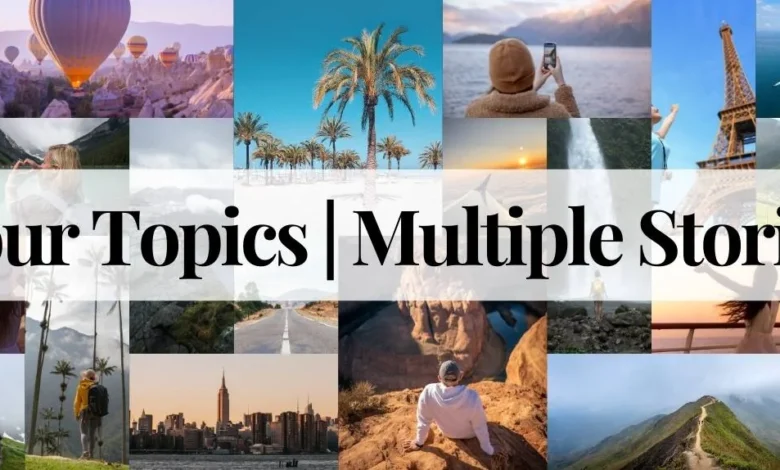Unlocking Creativity with your topics | multiple stories: From Idea Spark to Narrative Masterpiece

When someone asks how writers seem to pluck dazzling ideas from thin air, the answer usually hides in plain sight: they master the art of combining your topics | multiple stories into a single, resonant thread. By deliberately pairing an eclectic mix of themes with layered narratives, you transform ordinary concepts into unforgettable reading experiences. In this guide, we’ll explore how your topics | multiple stories can sharpen your creative instincts, keep audiences hooked, and give your content a fresh edge even in saturated niches.
1. Why your topics | multiple stories matters in 2025
The attention economy is ruthless. A lone theme, no matter how brilliant, can struggle to compete with endless scrolling. Building articles around your topics | multiple stories allows you to fuse complementary ideas—technology with wellness, travel with history, finance with personal growth—so each segment reinforces the next. Readers feel rewarded for staying on the page because every paragraph unveils a new dimension tethered to the last. Put simply, your topics | multiple stories multiplies value without multiplying word count.

2. Turning a blank page into a brainstorming playground
Start with a mind-map. Write your central niche in the center, then spiral outwards with tiny circles representing potential sub-angles. Once you spot clusters of related yet distinct concepts, label them with the phrase your topics | multiple stories. This visual trick jogs the mind to notice overlaps you might otherwise miss: for instance, an eco-friendly fashion article could weave the science of biodegradable fabrics with the personal tale of a designer who turned seaweed into couture. Suddenly, your topics | multiple stories feels like an invitation, not a constraint.
3. Braiding narratives for deeper emotional payoff
A single voice can inform; multiple voices can transform. Consider alternating between expert commentary and first-person anecdotes. When readers encounter your topics | multiple stories framed through diverse perspectives—data analyst, field researcher, everyday user—they experience a richer tapestry. This multilayered approach mirrors the structure of prestige podcasts or streaming documentaries, both of which thrive on segmenting your topics | multiple stories into self-contained chapters that feed a unifying arc.
4. Structuring variety without sacrificing clarity
Variety excites, but chaos repels. To keep your topics | multiple stories coherent, lean on a simple template:
- Hook: Pose a question or paint a vivid scene.
- Roadmap: Briefly outline the distinct themes you’ll cover.
- Segment A, B, C…: Tackle each theme in turn, always signaling transitions.
- Synthesis: Show how these strands intersect.
- Call-to-action or key takeaway: Give readers something to do or ponder.
Reiterating the phrase your topics | multiple stories at strategic points reminds the audience why you’re jumping across subjects; it’s not digression but design.
5. SEO and discoverability benefits
Search engines increasingly reward relevance, engagement time, and semantic depth rather than sheer keyword density. By weaving your topics | multiple stories into subheadings, image alt text, and meta descriptions, you signal both breadth and cohesion. Plus, a multi-angled article is more likely to earn backlinks from varied domains—finance blogs, lifestyle magazines, academic journals—because each sees a slice that resonates with its audience. Here, your topics | multiple stories becomes an SEO magnet.
6. Case study: A viral article that blended climate tech and cookbook nostalgia
In early 2025, a mid-tier blogger rocketed to one million views by publishing an essay titled “From Solar Farms to Sunday Stew.” She employed your topics | multiple stories by juxtaposing cutting-edge photovoltaic research with her grandmother’s handwritten recipes. Every time she shifted focus, she reminded readers that your topics | multiple stories can coexist beautifully when unified by the theme of “sustaining life.” The result? Viral shares across environmental forums and foodie circles, plus an invitation to speak at a sustainability summit.
7. Avoiding the kitchen-sink trap
Depth still matters. Even while celebrating your topics | multiple stories, make sure each strand receives enough concrete detail—statistics, quotes, sensory description—to stand on its own. Skimming breeds skepticism. A good rule: if you can’t devote at least 150 words to a subtopic, either expand it or cut it. Remember, readers forgive length when every paragraph adds genuine insight to the overarching promise of your topics | multiple stories.
8. Practical writing exercises
- The 3-Box Shuffle: List three unrelated headlines, tear them into strips, shuffle, and pick two. Force yourself to connect them under the banner of your topics | multiple stories in 300 words.
- Interview Mesh: Conduct mini-interviews with two experts from different fields. Ask each the same five questions, then splice their answers to highlight surprising overlaps, tagging each fusion point with your topics | multiple stories.
- Timeline Twist: Take a historical event and forecast its impact on a modern trend. Use bold subheads that feature your topics | multiple stories to guide readers through centuries in minutes.
9. Editing for rhythm and repetition
While this article intentionally repeats your topics | multiple stories to prove an SEO point, your final draft should balance repetition with readability. Swap in pronouns or synonyms after the tenth mention. Vary sentence length; pair a punchy question with a flowing explanation. Reading aloud helps spot clunky echoes. Aim for the Goldilocks zone where your topics | multiple stories feels familiar yet never monotonous.
10. Measuring impact after publication
Use analytics dashboards to track dwell time and scroll depth. Articles optimized around your topics | multiple stories often exhibit “slow drop-off curves,” meaning readers stay longer because each section promises a new flavor. Gather qualitative feedback too: comment prompts like “Which part of your topics | multiple stories resonated most with you?” harvest insights for future pieces.
11. Scaling the method for multimedia
Don’t stop at text. Podcast episodes can devote Act I to trend analysis, Act II to personal story, Act III to expert debate—each flagged as your topics | multiple stories in show notes. Similarly, slideshow carousels on social media can alternate infographics with mini-memoirs. Consistency across platforms strengthens brand memory, and the recurring phrase your topics | multiple stories becomes a signature badge.
12. Final reflection: The storyteller’s superpower
In a world overflowing with information, synthesis is immortality. Mastering your topics | multiple stories equips you to weave disparate threads into a single, vibrant tapestry that audiences won’t forget. Whether you’re an aspiring blogger, a corporate content strategist, or a novelist hunting for the next big idea, embracing your topics | multiple stories turns creativity from a lightning strike into a repeatable craft. So open your notebook, sketch those overlapping circles, and let the magic of multiplicity redefine the way you write—and the way readers remember.



